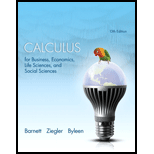
Concept explainers
C Problems 75 and 76 refer to the greatest integer function, which is denoted by 〚x〛 and is defined as
For example,
The graph of f(x) = 〚x〛 is shown. There, we can see that
and so on.

Figure for 75 and 76
75.
- (A) Is f continuous from the right at x = 0?
- (B) Is f continuous from the left at x = 0?
- (C) Is f continuous on the open interval (0, 1)?
- (D) Is f continuous on the closed interval [0, 1]?
- (E) Is f continuous on the half-closed interval [0, 1)?
Want to see the full answer?
Check out a sample textbook solution
Chapter 2 Solutions
Calculus for Business Economics Life Sciences and Social Sciences Plus NEW
- Problem 3 In their lab, engineer Daniel and Paulina are desperately trying to perfect time travel. But the problem is that their machine still struggles with power inconsistencies-sometimes generating too little energy, other times too much, causing unstable time jumps. To prevent catastrophic misjumps into the Jurassic era or the far future, they must calibrate the machine's power output. After extensive testing, they found that the time machine's power output follows a normal distribution, with an average energy level of 8.7 gigawatts and a standard deviation of 1.2 gigawatts. The Time Travel Safety Board has set strict guidelines: For a successful time jump, the machine's power must be between 8.5 and 9.5 gigawatts. What is the probability that a randomly selected time jump meets this precision requirement? Daniel suggests that adjusting the mean power output could improve time-travel accuracy. Can adjusting the mean reduce the number of dangerous misjumps? If yes, what should the…arrow_forwardProblem 5 ( Marybeth is also interested in the experiment from Problem 2 (associated with the enhancements for Captain America's shield), so she decides to start a detailed literature review on the subject. Among others, she found a paper where they used a 2"(4-1) fractional factorial design in the factors: (A) shield material, (B) throwing mechanism, (C) edge modification, and (D) handle adjustment. The experimental design used in the paper is shown in the table below. a. Run A B с D 1 (1) -1 -1 -1 1 2 a 1 -1 -1 1 3 bd -1 1 -1 1 4 abd 1 1 -1 1 5 cd -1 -1 1 -1 6 acd 1 -1 1 -1 7 bc -1 1 1 -1 abc 1 1 1 -1 paper? s) What was the generator used in the 2"(4-1) fractional factorial design described in the b. Based on the resolution of this design, what do you think about the generator used in the paper? Do you think it was a good choice, or would you have selected a different one? Explain your answer in detail.arrow_forwardNot use ai pleasearrow_forward
- In the xy-plane, an angle 0, in standard position, has a measure of the following is true? T. Which of 3 A The slope of the terminal ray of the angle is 1. B The slope of the terminal ray of the angle is 1. C D 3 The slope of the terminal ray of the angle is ✓ 2 The slope of the terminal ray of the angle is √3.arrow_forwardy'''-3y''+4y=e^2x Find particular solutionarrow_forwardNo chatgpt pls will upvote Already got wrong chatgpt answer Plzarrow_forward
- 1 -1- Ο Graph of f y = + y = 1 + 1/2 ·2· x Graph of g y = 1- 플 The figure gives the graphs of the functions f and g in the xy-plane. The function of is given by f(x) = tan¹ x. Which of the following defines g(x)? A tan 1 x + 1 B - tan 1 x + П 2 C tan-1 (2/2) + 1 D tan-1 (2/2) + 1/1arrow_forwardIn Problems 10-4, use the method of undetermined coefficients to determine the form of a particular solution for the given equation.arrow_forwardIn Problems 10-40, use the method of undetermined coefficients to determine the form of a particular solution for the given equation. 2 1. y"" - 2y" - 5y/+6y= e² + x²arrow_forward
- match the equation to it's respective directional field in the image, justify your answer a. dy/dx=x-1 b. dy/dx=1 - y^2 c. dy/dx=y^2 - x^2 d. dy/dx=1-x e. dy/dx=1-y f. dy/dx=x^2 - y^2 g. dy/dx=1+y h. dy/dx=y^2 - 1arrow_forward4. The runway at the Piarco International airport has an equation of -3(x-2y) = 6. If the Priority Bus Route passes through the geometric coordinate (1,-9) and is perpendicular to the runway at the Piarco International airport. Determine the following: a. State two geometric coordinates which the runway at the Piarco International airport passes through. b. Derive the equation of the Priority Bus Route. [2 marks] [6 marks]arrow_forwardUse Euler and Heun methods to solve y' = 2y-x, h=0.1, y(0)=0, compute y₁ys, calculate the Abs_Error.arrow_forward
 Algebra: Structure And Method, Book 1AlgebraISBN:9780395977224Author:Richard G. Brown, Mary P. Dolciani, Robert H. Sorgenfrey, William L. ColePublisher:McDougal LittellAlgebra & Trigonometry with Analytic GeometryAlgebraISBN:9781133382119Author:SwokowskiPublisher:Cengage
Algebra: Structure And Method, Book 1AlgebraISBN:9780395977224Author:Richard G. Brown, Mary P. Dolciani, Robert H. Sorgenfrey, William L. ColePublisher:McDougal LittellAlgebra & Trigonometry with Analytic GeometryAlgebraISBN:9781133382119Author:SwokowskiPublisher:Cengage Trigonometry (MindTap Course List)TrigonometryISBN:9781305652224Author:Charles P. McKeague, Mark D. TurnerPublisher:Cengage Learning
Trigonometry (MindTap Course List)TrigonometryISBN:9781305652224Author:Charles P. McKeague, Mark D. TurnerPublisher:Cengage Learning Glencoe Algebra 1, Student Edition, 9780079039897...AlgebraISBN:9780079039897Author:CarterPublisher:McGraw Hill
Glencoe Algebra 1, Student Edition, 9780079039897...AlgebraISBN:9780079039897Author:CarterPublisher:McGraw Hill Big Ideas Math A Bridge To Success Algebra 1: Stu...AlgebraISBN:9781680331141Author:HOUGHTON MIFFLIN HARCOURTPublisher:Houghton Mifflin Harcourt
Big Ideas Math A Bridge To Success Algebra 1: Stu...AlgebraISBN:9781680331141Author:HOUGHTON MIFFLIN HARCOURTPublisher:Houghton Mifflin Harcourt





